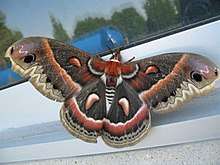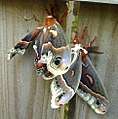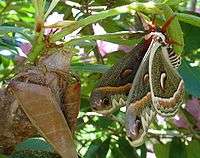Hyalophora cecropia
| Cecropia moth | |
|---|---|
| Hyalophora cecropia, Mounted Adult Female | |
 | |
| Living Adult Female | |
| Scientific classification | |
| Kingdom: | Animalia |
| Clade: | Euarthropoda |
| Class: | Insecta |
| Order: | Lepidoptera |
| Family: | Saturniidae |
| Genus: | Hyalophora |
| Species: | H. cecropia |
| Binomial name | |
| Hyalophora cecropia | |
| Synonyms | |
| |
The cecropia moth (hyalophora cecropia) is North America's largest native moth.[1] It is a member of the Saturniidae family, or giant silk moths. Females have been documented with a wingspan of five to seven inches (160 mm) or more. These moths can be found all across North America as far west as Washington and north into the majority of Canadian provinces.[2] Cecropia moth larvae are most commonly found on maple trees, but they have also been found on cherry and birch trees among many others.
Life cycle

Life span Like other members of the giant silk moth family, the cecropia moth lacks functional mouth parts and a digestive system. Due to this, they survive approximately two weeks.[3]
Mating To find a mate, the female cecropia moth emits pheromones which the male detects with its sensitive antennae. Male cecropia moths can detect these pheromones from up to a mile away, although a male may fly up to 7 miles while searching for a female. Mating typically begins early in the morning hours and lasts until the evening.
Eggs After mating, the female will lay up to one hundred eggs. These eggs are a mottled reddish brown color and are usually found on either side of a host leaf. These eggs will eventually hatch into tiny black caterpillars.
Larvae There are typically five larval instars (developmental stages), each lasting approximately one week. The first instar larvae are black in color. Their coloration is due to small black hairs growing from tubercles (small projections) all over their body. These larvae feed upon many common trees and shrubs including maple, birch, and apple.[4] As the caterpillars grow larger into the second larval instar, they become yellow-green in color. During the third, fourth, ad fifth instars, The cecropia moth becomes rather large andbluish-green. At these final stages, the tubercles become blue, yellow or orange, depending on body location, while the black hairs are eventually lost. The caterpillars reach maturity in Autumn and are about 4 to 4.5 inches long[5]
Pupae Once the caterpillars reach maturity, they spin large brown cocoons longways on trees or wooden structures. They will then emerge as adults in the first two weeks of seasonally warm weather in early Summer. Hyalophora cecropia moths are univoltine, having only one generation per year.
Adults Upon reaching adulthood, their size is variable. They are usually quite large, with a wingspan of about 5 to 7 inches. Cecropia moth's wings are brownish with red near the base of the forewing. There are crescent-shaped spots of red with whitish centers on all wings, but are larger on the hindwings. All wings have whitish coloration followed by reddish bands of shading beyond the postmedial line that runs longitudinally down the center of all four wings. The body is hairy, with reddish coloring on the anterior, and fading to reddish/whitish. The abdomen has alternating bands of red and white. [6]
Threats
Pests of the moths have become a significant problem.
Parasitoids, such as some species of wasps and flies, lay their eggs in or on the young caterpillars. The eggs then hatch into larvae, which consume the internal organs and muscles of the caterpillars. The parasitoid releases chemicals that override the regulatory mechanisms of the caterpillar. Once the parasitoid has grown enough, it induces the caterpillar to pupate. Once the caterpillars pupate, the parasitoid larvae themselves pupate, killing the cecropia pupa.[7]
Squirrels also consume the pupae of cecropia moths, which can decrease the populations significantly.
Pruning of trees and leaving outdoor lights on at night can also be detrimental to cecropia moths.
Compsilura concinnata, introduced to North America to control invasive European gypsy moths, is a particular threat to the native North American cecropia moth.[8]
In science
The original description of the insect juvenile hormone by Carrol M. Williams in Nature in 1956 is from the Cecropia silkworm (Platysamia cecropia L.= Hyalophora cecropia) the giant silkworm.[9] This large insect had enough juvenile hormone in its abdomen to permit extraction of detectable JH from a single abdomen.
In the media
In August 2012, a cecropia moth caterpillar was accidentally imported from Ontario to St. John's, Newfoundland, via a shipment of dogwood shrubs.[10] Cecropia are not native to the latter province.[2] Within 48 hours of its arrival the caterpillar began spinning a cocoon; it wintered at the federal Agriculture and Agri-Food research facility in St. John's, whence it had been transferred by the owner of the importing company. On 29 May 2013, the predominantly black and red female moth — named 'Georgina' by the facility's staff — emerged from her cocoon with a roughly 20 cm (7.9 in) wingspan. After allowing Georgina to complete her natural lifespan, researchers planned to pin and preserve her for future study.[11]
Life cycle gallery
- Cecropia eggs
 Caterpillar close-up
Caterpillar close-up Cocoon
Cocoon female pupa
female pupa- Male Adult
- Female Adult
 Adults mating
Adults mating Adult female, close-up
Adult female, close-up Adult male cecropia shortly after eclosion
Adult male cecropia shortly after eclosion
References
- ↑ "Cecropia Moth". National Wildlife Federation. NFW. Retrieved September 20, 2018.
- 1 2 Index to the Bombycoidea, Drepanoidea, Lasiocampoidea, and Mimallonoidea of Canada, with regional distributions, Canadian Biodiversity Information Facility, Government of Canada, 2004-02-18, retrieved 2013-06-12
- ↑ Cecropia Moth — Life Cycle
- ↑ Cecropia Moth - Hyalophora cecropia
- ↑ Gallice, Geoffrey. "Cecropia Moth". University of Florida. Retrieved September 20, 2018.
- ↑ Gallice, Geoffrey. Featured Creatures. University of Florida http://entnemdept.ufl.edu/creatures/bfly/moth2/cecropia_moth.htm. Missing or empty
|title=(help) - ↑ "Parasites, Predators and Parasitoids". Moth Photographers Group. Retrieved September 20, 2018.
- ↑ Elkinton, J. S.; Boettner, G. H. The Effects of COMPSILURA CONCINNATA, an Introduced Generalist Tachinid, on Non-Target Species in North America: A Cautionary Tale (PDF).
- ↑ Nature (1956) Vol. 178 No. 4526 Pages 212-213, Carrol M Williams: The Juvenile Hormone of Insects
- ↑ "An uncommon visitor with many little legs". CBC News. 2012-08-08. Retrieved 2013-05-31.
- ↑ "Rare stowaway turns into spectacular moth". CBC News. 2013-05-31. Retrieved 2013-05-31.
External links
| Wikimedia Commons has media related to Hyalophora cecropia. |
| Wikispecies has information related to Hyalophora cecropia |
- Picture journal of cecropia development (warning, it may take a while to load)
- The cecropia moth
- Video presentation of mating Cecropia moths. One had just emerged from and was still on its cocoon: ,
- cecropia moth on the UF / IFAS Featured Creatures Web site